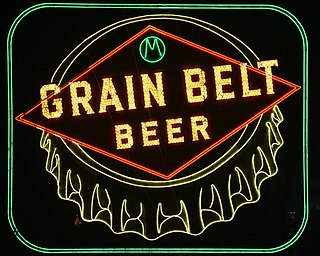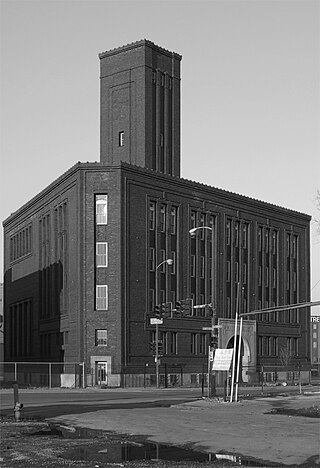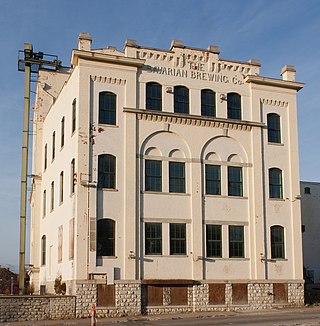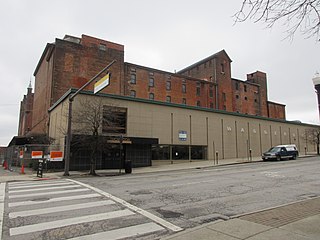
Fair Haven is a neighborhood in the eastern part of the city of New Haven, Connecticut, between the Mill and Quinnipiac rivers. The northeast section of the neighborhood is also known as Chatham Square.

Grain Belt is a brand of beer brewed in the American state of Minnesota, by the August Schell Brewing Company. The beer has been produced in a number of varieties. Grain Belt Golden was the original style introduced in 1893. The current offerings are: Grain Belt Premium, first introduced in 1947; Grain Belt Premium Light; Grain Belt Nordeast, introduced on April 7, 2010; and the newest offering, Grain Belt Lock & Dam, introduced in 2016. It was originally produced by the Minneapolis Brewing Company which formed with the merger of four smaller brewers in 1891. Soon after introduction, Grain Belt became the company's flagship product. It was brewed at the original Grain Belt brewery in Minneapolis, Minnesota until 1976. A series of other owners followed, and Schell took over the product line in 2002.

The Valentin Blatz Brewing Company was an American brewery based in Milwaukee, Wisconsin. It produced Blatz Beer from 1851 until 1959, when the label was sold to Pabst Brewing Company.

The Pabst Brewery Complex, on a hill northwest of the downtown of Milwaukee, Wisconsin, is the former brewery of the Pabst Brewing Company, where the company innovated to improve their beer and increase production until in 1892 it was the largest brewer of lager in the world. In 2003 the complex was listed on the National Register of Historic Places.

The Schoenhofen Brewery Historic District is centered on the former site of the Peter Schoenhofen Brewing Company at 18th and Canalport Avenue in the Pilsen neighborhood of Chicago, Illinois.

The Henry Weinhard Brewery complex, also the Cellar Building and Brewhouse and Henry Weinhard's City Brewery, is a former brewery in Portland, Oregon. Since 2000, it has been listed on the National Register of Historic Places. In that same year, construction began to reuse the property as a multi-block, mixed-use development known as the Brewery Blocks.

The Tennessee Brewery building stands at the intersection of Butler and Tennessee streets in Memphis, Tennessee. It is directly on the bluff overlooking the Mississippi River. The building once housed the Tennessee Brewing Company, a leader in early brewery production.

Fitger's Brewing Company was a beer manufacturer in Duluth, Minnesota, United States, from 1881 to 1972. The surviving brewery complex stretches for 720 feet (220 m) along the Lake Superior shoreline and East Superior Street, one of Duluth's main roads. The majority of the ten-building complex was constructed between 1886 and 1911. Fitger's, as it is now known, has undergone adaptive reuse as an indoor mall with shops, restaurants, nightclubs, a hotel, and a museum on the brewery's history.

The Lembeck and Betz Eagle Brewing Company was founded in 1869 by Henry B. Lembeck and John F. Betz in Jersey City, in Hudson County, New Jersey, United States. The brewery, bounded by 9th, 10th, Grove, and Henderson streets in downtown Jersey City, developed into one of the most famous, best-equipped, and financially successful breweries on the East Coast of the United States.

The Upper Peninsula Brewing Company Building is an office building located at the intersection of Meeske Street and US 41 in Marquette, Michigan. It is also known as the Charles Meeske House. The structure served as the home and office of brewer Charles Meeske, secretary-treasurer and later president of the company. It was listed on the National Register of Historic Places in 1980.

Bavarian Brewing Company was a brewery established in Covington, Kentucky, in 1866 by Julius Deglow, but became known as the Bavarian Brewery around 1870. The brewery was originally located on Pike Street, but expanded to 12th Street within a decade. After John Meyer acquired the brewery in 1881, he sold an interest to William Riedlin in 1882. The company operated under the proprietorship of Meyer & Riedlin starting in 1884, before becoming incorporated as the Bavarian Brewery Co. in 1889 by William Riedlin. The company was family owned until it was acquired by International Breweries, Inc.(IBI) in 1959. However, it operated as the Bavarian Division of IBI and continued to produce its flagship beer, Bavarian's, until the facility closed in 1966. The property was placed on the National Register of Historic Places and renovated as a multipurpose complex for food, beverage and entertainment uses in 1996. It operated as the Brew Works at the Party Source and Jillian's, but closed in 2006. The former structure containing the Brew and Mill Houses, built in 1911, was repurposed into office space becoming part of the Kenton County Government Center, opening in 2019. This office complex has a Bavarian Brewery Exhibit and it is accompanied by a Bavarian Brewery website.

The Potosi Brewery is located in Potosi, Wisconsin, United States. It was added to the National Register of Historic Places in 1980.

The Neuweiler Brewery, also known as the Germania Brewery, is an historic brewery complex located in Allentown, Pennsylvania. Built between 1911 and 1913, the complex consists of the office building, brew house, stock house, pump house, wash house, chemistry lab building, boiler room, bottling house, garage, fermenting cellar, and smokestack with the name "Neuweiler" on it.

The Duquesne Brewing Company was a major brewery in Pittsburgh, Pennsylvania, from its founding in 1899 until its dissolution in 1972. The brand was revived under the name Duquesne Brewing Company in 2008, in order to re-establish the beer in Western Pennsylvania starting in the summer of 2010.

The Highland Spring Brewery Bottling and Storage Buildings, including the Oliver Ditson Company Building, are located at 154-166 Terrace St. in the Mission Hill neighborhood of Boston, Massachusetts. This complex consists of several brick industrial buildings. constructed over time beginning in 1892. The main building, a four-story Romanesque structure at 164 Terrace Street, was built that year by the Highland Spring Brewery. A second, five-story Georgian Revival building was added in 1912; this building was acquired in 1925 by the Oliver Ditson Company, a leading 19th century publisher of sheet music.

Mission Brewery Plaza is a historic brewery building in the Middletown neighborhood of San Diego, California. The building was added to the National Register of Historic Places on July 6, 1989. It is also the name of a San Diego microbrewery which opened in 2007 and operates in a different neighborhood in San Diego.

Peacock Brewery, also known at times as the Rockford Brewing Company and the Rock River Brewing Company, is a historic pair of buildings on the east side of the Rock River in Rockford, Illinois, United States. It was Rockford's largest brewery for almost seventy years.

The American Brewing Company Plant, owned by the American Brewing Company, is a historic brewery complex at 431 Harris Avenue in Providence, Rhode Island that operated between 1892 and 1922. It is a well-preserved example of a state of the art late 19th century brewery building, its original functions still discernible in its layout. It was only used as a brewery until 1922, when it was shut down by Prohibition; it has served as a warehouse and storage facility for most of the time since. The complex was listed on the National Register of Historic Places in 2016.

The L. Hoster Brewing Company is set of historic buildings in the Brewery District of Columbus, Ohio, United States. The site was listed on the National Register of Historic Places in 2009.


























